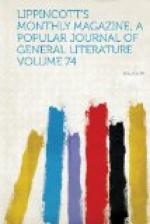The name of each is called out loudly by the lord chamberlain: “The duchess of Fincastle,” “The countess of Dorchester,” “Lady Arabella Darling on her marriage,” etc. The ladies bow very low, and those to whom the queen gives her hand to kiss nearly or quite touch their knee to the carpet. No act of homage to the queen ever seems exaggerated, her behavior being so modest and the sympathy with her so wide and sincere; but ladies very nearly kneel in shaking hands with any member of the royal family, not only at court, but elsewhere. It is not so strange-looking, the kneeling to a royal lady, but to see a stately mother or some soft maiden rendering such an act of homage to a chit of a boy or a gross young gentleman impresses one unpleasantly. The curtsy of a lady to a prince or princess is something between kneeling and that queer genuflection one meets in the English agricultural districts: the props of the boys and girls seem momentarily to be knocked away, and they suddenly catch themselves in descending. It astonished me, I remember, at a court party, to see one patrician young woman—“divinely tall” I should describe her if her decided chin and the evidently Roman turn of her nose and of her character had not put divinity out of the question—shake hands with a not very imposing young prince, and bend her regal knees into this curious and sudden little cramp. I saw her, this adventurous maid, some days afterward in a hansom cab (shade of her grandmother, think of it!), directing with her imperious parasol the cabby to this and that shop. It struck me she should have been a Roman damsel, and have driven a chariot with three steeds abreast.
The levees and the drawing-rooms may be called the court ceremonials. There are besides the court festivities, the balls and concerts at Buckingham Palace. There are four or five of these given in a season—two balls and two concerts. The balls are the larger and less select, but much the more amusing. The ball-room of the palace is a large rectangular apartment. At one end is the orchestra—at the other a raised dais on which the royalties sit. On each side, running the length of the hall, are three tiers of benches, which are for ladies and such gentlemen as can get a seat. The tiers on the left of the dais are for diplomatists. English society has the tiers upon the other side. By ten the ball-room is usually filled with people waiting for the appearance of the royalties. The band strikes up, and the line of princes and princesses advances down the long hall leading to the ball-room. The queen and Prince Albert used formerly to preside at these balls. The queen does not come now: the prince and princess of Wales take her place.




